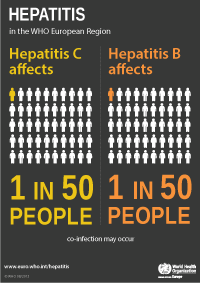Data and statistics

Hepatitis is an inflammation of the liver, most commonly caused by a viral infection. The five main strains of hepatitis viruses are A, B, C, D and E.
Hepatitis A and E are typically caused by ingestion of contaminated food or water while hepatitis B, C and D usually occur as a result of blood-to-blood contact with infected body fluids (e.g. from blood transfusions or invasive medical procedures using contaminated equipment). Hepatitis B and C can also be transmitted through sexual contact, although this is less common with hepatitis C.
Symptoms include jaundice (yellowing of the skin and eyes), dark urine, extreme fatigue, nausea, vomiting and abdominal pain. Hepatitis infections, however, remain asymptomatic in the majority of cases, and are hard to detect without proper testing.
Hepatitis B and C affect millions of people in the European Region. Worldwide, 500 million people are estimated to be infected with hepatitis B or C. These viruses kill 1.5 million people a year; 1 in every 3 people has been exposed to either or both viruses and most infected people do not know about it due to dormant symptoms.
Data that has recently become available, shows that in the WHO European Region an estimated 13.3 million people live with chronic hepatitis B (1.8% of adults) and an estimated 15 million people with hepatitis C (2.0% of adults). Two-thirds of infected persons in the Region live in eastern Europe and central Asia. Hepatitis B causes about 36 000 deaths and hepatitis C about 86 000 deaths per year in WHO European Member States.
The number of cases of hepatitis B and C reported in the WHO European Region does not necessarily reflect the full extent of transmission. A synthesis report on effective interventions to reduce hepatitis C infection from WHO/Europe’s Health Evidence Network (HEN) estimates prevalence of up to 98% among people who inject drugs.
The European Centre for Disease Prevention and Control (ECDC) estimates:
- an overall hepatitis B incidence of 1.49 per 100 000;
- a hepatitis C incidence of 8.7 per 100 000 in the Member States of the European Union (EU); and
- high prevalence in people who inject drugs.



